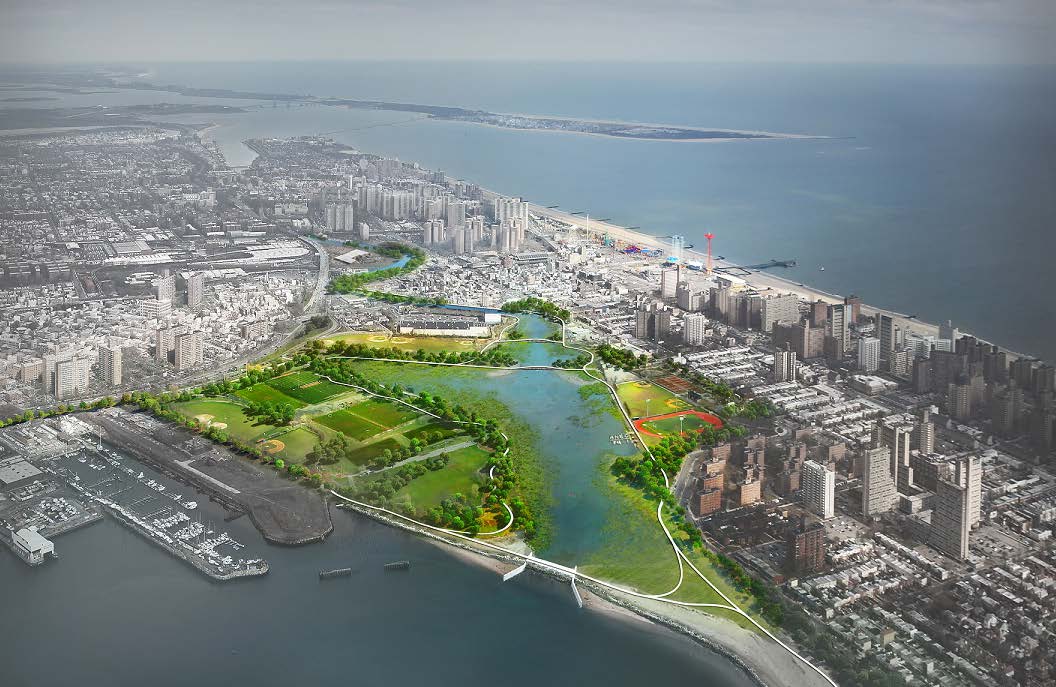Climate Resiliency in the Sandy-Impacted Region
HR&A advises city, state, federal, nonprofit and private entities as they develop projects across the northeastern United States that both promote recovery from Hurricane Sandy and make people, property and infrastructure more resilient in light of increasing hazards and vulnerabilities in the future.
Our work includes contributions to the transformative visioning and community planning efforts of Rebuild by Design in Red Hook, the Rockaways, the New Jersey Shore, Hunts Point and Hoboken, delivery of the New York Rising Community Reconstruction Program, and capacity building within the National Disaster Resilience Competition, as well as feasibility analysis and project design for infrastructure and community development projects in New York and New Jersey, and groundbreaking studies of key resiliency issues such as flood insurance and incentives and tools for business adaptation. HR&A deploys creative approaches to public-private financing, policy change, and community and stakeholder engagement to improve projects and maximize their viability.
On behalf of the New York City Economic Development Corporation (NYCEDC) and the Mayor’s Office of Recovery and Resiliency, HR&A led the economic, planning, and regulatory components of a multidisciplinary feasibility study of a Southern Manhattan Multi-Purpose Levee that could integrate flood protection with new housing, commercial development, and open space uses. HR&A:
- Managed a team composed of planners, lawyers, and consultants that evaluated regulatory obstacles for project implementation;
- Tested multiple scenarios against a set of project goals, including enhancing flood protection for Southern Manhattan;
- Led real estate and financial analyses for the project, including preparation of a dynamic pro forma to test multiple alternatives.
HR&A supported the development of a comprehensive tidal barrier and wetlands strategy for Coney Island Creek and a plan for storm surge barrier systems for the Gowanus Canal and Newtown Creek. As part of a holistic approach to assessing the feasibility of new flood protection systems, HR&A:
- Supported the consideration of social and economic impacts of flood protection on adjacent neighborhoods, including the value of risk reduction and amenity creation;
- Conducted an initial market analysis of the areas surrounding Coney Island Creek to identify highest and best use of suitable redevelopment sites;
- Supported the creation of an implementation and phasing strategy to inform phasing for the Coney Island Creek flood protection system and surrounding redevelopment opportunities;
- Identified opportunities to integrate flood control infrastructure with current and future real estate and infrastructure development activities along the Brooklyn-Queens waterfront;
- Created a funding strategy for barriers along Gowanus Canal and Newtown Creek that integrates both conventional and innovative infrastructure capital and O&M funding sources.
For NYCEDC and the Mayor’s Office of Recovery and Resiliency, HR&A led a team to study the impacts of flood insurance on New York City’s multifamily and mixed-use housing stock. In light of recent changes affecting flood insurance regulations, including revised federal flood map boundaries and impending premium increases, HR&A:
- Built a comprehensive database of the city’s multifamily building stock, categorizing this data by type, including age, number of units or stories, and owner vs. rental tenure);
- Designed and implemented a survey to determine flood insurance costs and incidence for a range of multifamily buildings;
- Recommended actionable policy changes and mitigation strategies as responses to changing flood insurance costs for multifamily and mixed-use buildings.
As part of a team led by Curtis + Ginsberg Architects, HR&A supported work on behalf of the New York City Housing Authority’s (NYCHA) Sandy Resiliency & Renewal Program in Coney Island. For three NYCHA developments in Coney Island, including O’Dwyer Gardens, Surfside Gardens, and Coney Island Site 8, HR&A collaborated with the team to identify potential uses for ground-floor space created by the development of new infrastructure on-site and other resiliency improvements. The results of the preliminary analysis informed the team’s broader basis of design and scope for comprehensive resiliency improvements across the sites, as well as NYCHA’s investment decisions with regard to the campuses.
HR&A has led a number of other projects guiding the transformative visioning and community planning efforts taking place throughout the region. For the New York Governor’s Office of Storm Recovery, HR&A led a multidisciplinary team of engineers, architects, planners, and healthcare specialists through both rounds of the NY Rising Community Reconstruction Program. HR&A led or participated on three of ten finalists teams in the Rebuild by Design competition launched by the U.S. Department of Housing and Urban Development (HUD) to promote resilience for the Hurricane Sandy-affected region. From 2014-2016, HR&A was program manager for The Rockefeller Foundation’s Capacity Building Initiative in support of HUD’s National Disaster Resilience Competition.

Coney Island Creek Tidal Barrier